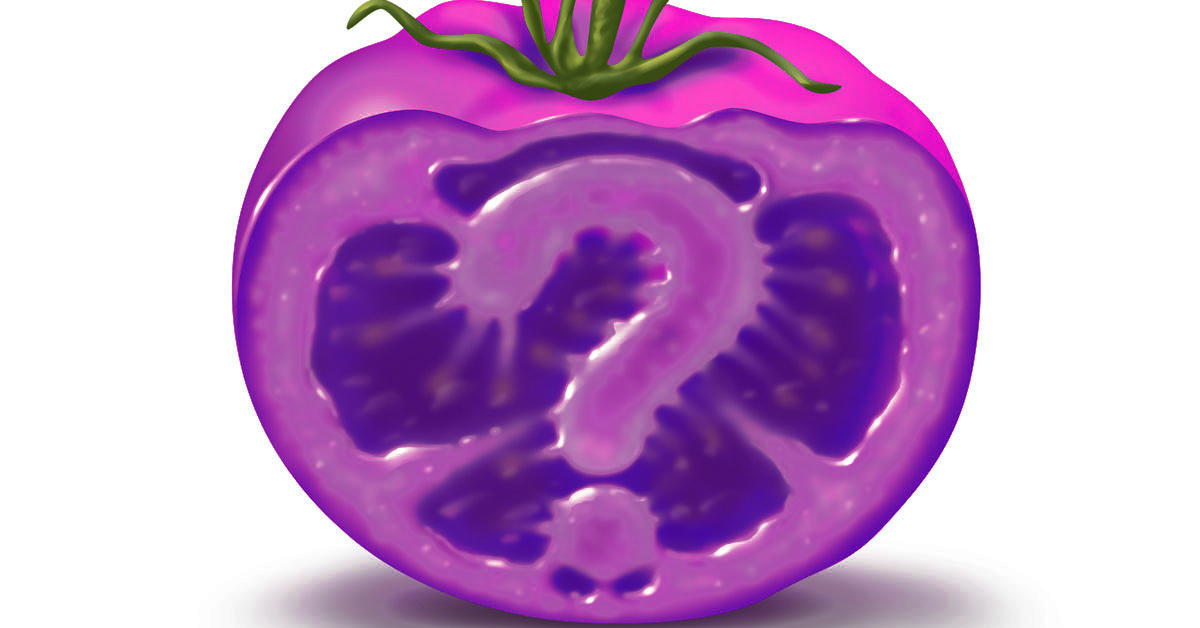
Dr Ray Seidler explains why caution is needed
 Recently the US Department of Agriculture (USDA) approved the commercial production and sale of a new purple coloured genetically modified (GM) tomato, known as the “purple tomato”. The US Food and Drug Administration, which is responsible for food safety, has yet to approve it.[1] Here, once again, we have an unnecessary food product, genetically engineered for patent protection – a financially motivated concept – and without human safety testing.
Recently the US Department of Agriculture (USDA) approved the commercial production and sale of a new purple coloured genetically modified (GM) tomato, known as the “purple tomato”. The US Food and Drug Administration, which is responsible for food safety, has yet to approve it.[1] Here, once again, we have an unnecessary food product, genetically engineered for patent protection – a financially motivated concept – and without human safety testing.
Anthocyanins are a group of water-soluble phenolic pigments that give the tomato its purple colour. It is not a dominant group of compounds in red tomatoes. The purple tomato is genetically engineered to cause over-expression of this particular group of polyphenolic anthocyanin pigments.
There are already numerous (heritage) varieties of natural purple tomatoes, so why would we need another one that is genetically engineered? The heritage varieties have anthocyanins mostly concentrated in their skin, whereas the GM variety has them all the way through the fruit – hence the unusually high levels.
The producers of the purple tomato are quoted as saying, “The tomatoes may… mark a turning point for genetically modified foods nationwide. The engineered trait is meant to entice the shopper, not the farmer.” The inventors, Professors Cathie Martin and Jonathan Jones, have formed a private spinout company, Norfolk Plant Sciences, to sell the GM tomato seeds.
The USDA Animal and Plant Health Inspection Service (APHIS), “has determined that Norfolk Plant Sciences’ “modified tomato is unlikely to pose an increased plant pest risk relative to its [non-GM] comparator”. Increased risk of being a plant pest is the wrong issue to evaluate risk assessments of GM foods and doesn’t come close to representing the whole spectrum of risks from cultivated GM crops, but that is what the USDA regulation requires. If they are not a plant pest, the USDA thinks they must be OK for environmental release and can be grown commercially.
When consumed in moderation, anti-inflammatory compounds like anthocyanins can have health benefits. But too much of a good thing may not be good. It has been demonstrated that over-consumption of anthocyanins (e.g. when taken as pill supplements) may cause kidney, liver, and thyroid hormone health effects. Anthocyanins are part of a group of compounds called polyphenols, which may also limit or interfere with iron absorption.
The average American consumes around 12.5 milligrams of these antioxidants per day. The anthocyanin content from the GM tomato averages about 500mg/100gm of fresh fruit, some 40 times more than the daily average consumption. One hundred grams of tomato is less than half a cup. Other naturally purple coloured fruits (sweet cherries, blackberries, strawberries, red raspberries, black grapes) contain anthocyanins in the range of 3-143mg/100gm, up to 160-fold less than the GM purple tomato.
A mini-review from Harvard University and University of Melbourne scientists asserts the need for increased regulation and guidelines for polyphenol consumption and supplementation in order to ensure that consumers remain safe and informed about polyphenols (like anthocyanins). When taken in pill form it may be easily possible to exceed safe levels, potentially causing serious ailments. For example, one commercial pill formulation prepared from sour cherries recommends two pills, with a resulting daily dose of 40mg of anthocyanins. This 40mg per day might be a concern to the Harvard scientists, but it represents only 8% of the 500mg level found in 0.4 cups of the fresh GM tomato.
The US Food and Drug Administration allows health claims for antioxidant nutrients with an established Recommended Daily Intake (RDI) – for example, vitamins A and C. But polyphenols are not a vitamin and nor do they have an RDI. Polyphenols are often sold as nutritional supplements (pills), which are minimally regulated in the US, meaning a greater number of functional claims can be made. There are currently no regulatory recommendations for the quantity of consumption of polyphenols in foods.
The potential for the consumption of deleterious levels of polyphenols is especially of concern with supplements (pills) and may happen through over-indulgence in certain foods. Some manufacturers recommend pill intakes over 100-fold higher than those currently associated with a Western diet. In some cases, supplementation trials of antioxidants have been associated with adverse effects, including increased mortality or stroke. The current lack of “nutritional supplement” regulations in the US may contribute to overhyped claims, potentially resulting in over consumption of pills or overconsumption of a fad food like the new GM purple tomato at potentially harmful levels.
In the US, stickers are placed on many foods, especially fresh vegetables and fruits, indicating how they were produced. If it is labelled with 5 digits beginning with an 8, it ain’t great: It’s genetically engineered and likely contains pesticides. If it is labelled with 4 digits beginning with a 3 or 4, close the door and walk away (it’s conventionally grown and probably contains pesticides). If it is labelled with 5 digits beginning with a 9, it should be fine (it’s organic).[2] A non-GMO label means it’s been tested and found not to contain genetically engineered genes.
Lastly, we should not forget that Jackson County, Oregon, where I live, is one of eight GMO-free counties in the United States. Despite a challenge to the original 2014 ordinance that prohibits the planting of GM seeds and passed by County voters by a margin of 2:1, subsequent legal challenges failed and the ordinance stands. This means no GM purple tomato seeds can be legally planted in Jackson County, Oregon. However, we should also not forget that the purple tomato can be sold in local stores. Limited distribution in the US is expected in 2023.
I advise shoppers to treat GM purple tomatoes with caution.
GMWatch editor's notes
1. The FDA doesn't approve GM foods as safe in its own estimation. It only undertakes a voluntary (voluntary to the company applicant) review of a GM food and sends a "no questions" letter to the company applying to sell the GM food if it has no further questions. In the letter, it reminds the company that it is the company's responsibility, not that of the FDA, to only to put safe foods on the market.
2. According to US-based Jeffrey Smith of the Institute for Responsible Technology, the numbers system is “a voluntary system created by a produce marketing association to help with inventory control, in case any company wants to label products as GMOs. It hasn’t ever been used, to my knowledge. In an interview with the association, they said it was never designed for consumer identification.” CBAN also notes on their website: "There is no code for GMOs. The code number '8' is NO LONGER USED FOR GMOS: The International Federation for Produce Standards set aside a number (8) for identifying GM foods but it was not being used and was changed in 2015 to identify conventionally produce (not organic) food. The code number '9' denotes organic produce: This code distinguish between organic and conventionally produced fresh fruits and vegetables. Organic food is produced without the use of any genetically modified organisms. Organic produce is identified with a number that begins with '9': for example, 4011 identifies a conventionally grown papaya and 94011 identifies an organically grown papaya. But organic food is already identified with the national Canada Organic standard logo."
Dr Ray Seidler has taught and conducted research at five major US universities. He spent half his career as a professor of microbiology at Oregon State University and another 16 years as a senior research scientist at the US Environmental Protection Agency (EPA). While at the EPA he headed the US’s first genetically engineered organism risk assessment program. He has published over 150 peer reviewed articles on various aspects of environmental microbiology. He is currently retired.










